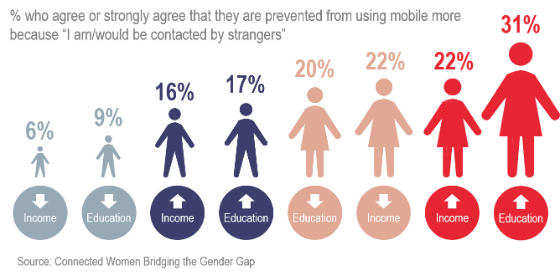This blog is the second in a series of blogs examining the findings from the Bridging the Gender Gap report for Kenya. Here we highlight the explosion in popularity of call blocking apps in Kenya (and across emerging markets) and examine the social and commercial opportunity for the mobile industry to help women feel safer on their mobile.
To see a summary of the full report findings for Kenya see The top 10 things you need to know about women and mobile in Kenya
The growth of the call blocker app
Over the last couple of years much has been made of the rapid growth of Whatsapp and Facebook across emerging markets. However, few people are talking about one of the biggest trends in emerging market app stores – the explosion in popularity of call blocking apps. These apps allow mobile users to identify and block harassing mobile numbers and often include features that can reveal the name or location of the caller. One of the most popular call blocking apps is Truecaller, an app which last year saw 500% growth among sub-Saharan African users. Today Truecaller has over 100 million users worldwide, hardly an insignificant figure when compared with app giants Instagram (~300m users), Twitter (~240m users) and Snapchat (~200m users).
Emerging markets leading the charge
By analysing Google Play Store data it is possible to measure the popularity of call blocking apps on a country by country basis. The heatmap below shows how high call blocking apps rank in each country’s top 500 most popular apps where the hotter the colour, the higher the ranking. The ranking is based on the 500 most downloaded free apps in each country’s Google Play Store* during the 1st July 2015.
*Apple App Store data is used where Google Play Store data is not available or where iOS has a larger share of operating systems
Excluding Sweden, where Truecaller originated, the hotter yellow, orange and red colours are entirely confined to the Middle East and North Africa, sub-Saharan Africa and South Asia. Kenya, Jordan and Mozambique are the darkest red meaning that a call blocking app ranks in the top 5 most popular apps by download. Astonishingly Truecaller ranked as high as second in Kenya’s Google Play Store on 1st July, just behind Whatsapp, with daily downloads above apps such as Facebook and Instagram. What’s more, there are 4 different call blocking apps in Kenya’s Google Play Store top 100, more than any other market in the world.
Women feeling the pain
As part of GSMA Connected Women’s research report Bridging the Gender Gap: Mobile access and usage in low- and middle-income countries 1,000 male and female mobile users and non-users in Kenya were asked what factors prevent them from using mobile. In Kenya it was found that concerns about mobile security and harassment are some of the most common barriers to people using their mobile, just behind poor quality coverage and the cost of handset/airtime. However, segmenting by gender, income and education shows that concerns about harassing calls do not affect all Kenyans equally. The chart below shows the percentage of people in each segment who agree or strongly agree that they are prevented from using mobile more because of concerns about being contacted by strangers.
What is clear is that women are consistently more likely than men to be concerned about harassing calls. This issue is most commonly cited among more affluent or educated segments with 31% of the higher educated female segment in Kenya reporting mobile harassment as a barrier to them using mobile.
The opportunity
Despite the immense popularity of call blocking apps in Kenya, mobile harassment remains a serious issue. While these apps are a powerful way for smartphone owners to identify and block harassing calls, these services only go some way to addressing the problem. The vast majority of Kenyan mobile subscribers are using basic or feature phones and so cannot use apps such as Truecaller. While mobile operators in Kenya do provide call blocking services for more basic phones, awareness of how to use these services is low as they are considerably less user friendly and not widely marketed.
It is also important to note that the growth of social media in Kenya has opened up new channels for harassment which these apps can’t address. Focus groups with urban women in Kenya revealed a number of stories of women facing online abuse, particularly through Facebook. GSMA’s Accelerating Digital Literacy: Empowering women to use the mobile internet report found that although many women are concerned about online harassment or exposure to offensive online content, few women in Kenya are aware of features such as privacy settings on Facebook or filters on Google search.
Mobile harassment is not just a social or consumer issue. When a significant proportion of mobile subscribers, particularly among more affluent segments, are claiming they are prevented from using their mobile for fear of harassment, this represents a missed revenue opportunity for operators and the wider mobile ecosystem. Increasing people’s sense of security using mobile could not only increase voice and mobile data usage but also improve the level of trust in the mobile industry as a whole.



